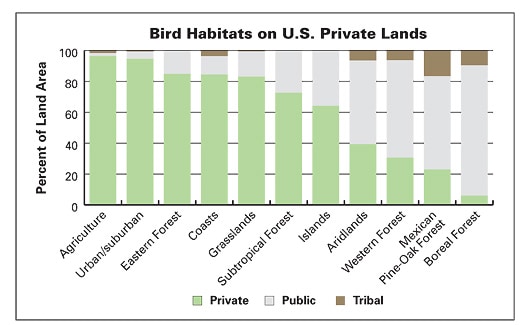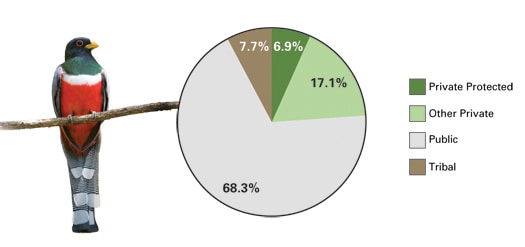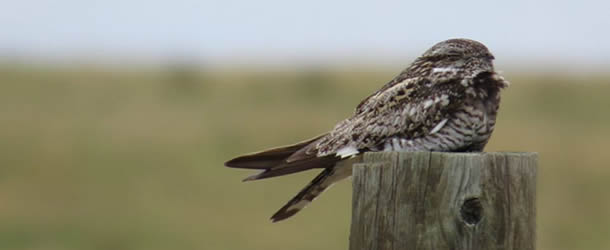When land does well for its owner, and the owner does well by his land; when both end up better by reason of their partnership, we have conservation. —Aldo Leopold, The Farmer as a Conservationist
On July 2, 2013 the 2013 U.S. State of the Birds Report was released, the nation’s first review of bird distribution and conservation opportunities on private lands. This collaborative effort of the North American Bird Conservation Initiative included partners from across the country and highlights the enormous contributions private landowners make to bird and habitat conservation. In the report you can read about endangered species whose populations are supported almost entirely by private lands, such as the Golden-cheeked Warbler of central Texas. You’ll also learn about innovative win-win solutions for working lands, like the conservation easement on 240,000 acres of aridlands on the Tejon Ranch in southern California, preserving and enhancing bird populations and biodiversity while preserving traditional land uses such as grazing.
Private landowners, including two million ranchers and farmers and about 10 million woodland owners, own and manage 1.43 billion acres, roughly 60% of the land area of the United States. Private lands are used by virtually all of the terrestrial and coastal birds of the U.S., 251 of which are federally threatened, endangered or of conservation concern. Many privately owned working lands that produce food, timber, and other resources for society also provide valuable habitat for birds.

The scientific data show a very high dependence on private lands among grassland, wetland, and eastern forest birds, as well as the tremendous potential for bird conservation. Half of the more than 200 bird species analyzed in this report have 50% or more of their distributions on private lands in the U.S.[list style=”list1″]
- Privately-owned wetlands support more than 75% of the breeding and wintering distributions of waterfowl such as Blue-winged Teal, Northern Pintail, and Wood Duck.
- Coastal areas constitute only 9% of the total land area of the U.S. (excluding Alaska and Caribbean and Pacific Islands), but 25% of all bird species in North America use coastal habitats for some part of their annual cycle.
- Seven breeding obligate grassland bird species, including Eastern Meadowlark and Dickcissel, have more than 90% of their distribution on private lands.
- Privately-owned aridlands contain 40% of breeding and 43% of wintering aridland bird distributions. Arizona’s population increased over 300% between 1960 and 2000, and projected future population increases could increase development pressure on important bird habitats.
- Mexican pine-oak forest is 23% privately owned, including more than 82,000 acres of private protected lands that, in conjunction with adjacent public lands, preserve unique forest ecosystems in mountain canyons and other riparian areas.[/list]

Success Stories
The report highlights success stories of the real and meaningful conservation impacts that the actions of voluntary private landowners can have on birds and their habitats.[list style=”list1″]
- The Sonoran Desert Conservation Plan has protected more than 230,000 acres of Sonoran desert and semi-desert grassland habitat, including 87,000 acres of private land for the benefit of birds such as Elf Owl, Gilded Flicker, Phainopepla, Pyrrhuloxia, Costa’s Hummingbird, Bell’s Vireo, and Varied Bunting.
- The Tejon Ranch, in southern California, created a permanent conservation easement on 240,000 acres and established the Tejon Ranch Conservancy to guide conservation planning, monitoring, and stewardship under the easement. This effort supports birds such as California Condor, Le Conte’s Thrasher, Lark and Black-throated Sparrows, and Lawrence’s Goldfinch.
- SJV partners Joe and Valer Austin have restored the natural hydrology of the mountain canyon on their 1,920-acre El Coronado Ranch on the west side of the Chiricahua Mountains in Arizona, revitalizing both the aquatic habitat and the adjacent forests, while increasing the productivity of their ranch. [/list]
The report’s take-home message is this: both birds and people rely on private lands, and that reliance is only going to increase as populations grow and our demand for things like food, timber, and energy increase. In order to support these growing needs, we must develop and support the continued use of creative strategies, programs, and partnerships for working landscapes that support not only the people whose livelihoods rely on them, but also the conservation of bird populations.
You can download the complete State of the Birds 2013: Report on Private Lands at http://stateofthebirds.org. You can also view more detailed information about specific habitats, as well as landowner efforts to support bird conservation. Finally, you can view detailed species distribution maps, supported by eBird data.

